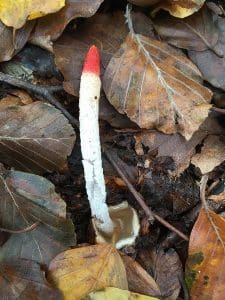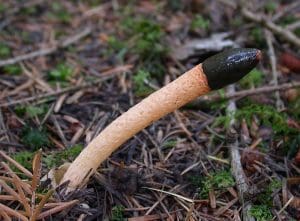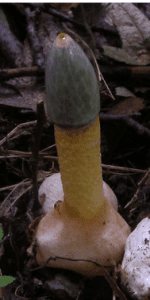Dog Stinkhorn / Summer / Autumn / Inedible
Dog Stinkhorn (Mutinus caninus) is one of those fascinating yet divisive fungi that foragers love to learn about – or love to avoid!
With its unique shape, bold colours, and, let’s be honest, unforgettable odour, it’s certainly one of the most distinctive fungi you’ll encounter in the woods.
Although its appearance may be off-putting to some, Dog Stinkhorn offers a fantastic opportunity for foragers to hone their identification skills, helping you spot this unusual mushroom at various stages of growth.
In this guide, we’ll explore how to identify Dog Stinkhorn in its natural habitat, what makes it so unique, and why it’s a mushroom that will leave an impression on any curious forager.
Common Names
Dog Stinkhorn
Scientific Classification:
Mutinus Caninus
Kingdom:
Fungi
Order:
Phallales
Class:
Agaricomycetes
Family:
Phallaceae
Genus:
Mutinus
Growing Season:
This mushroom often develops throughout the summer and autumn periods. It can be found mostly in Britain and Ireland, as well as parts of Europe and North America.
Habitat:
Dog Stinkhorns are considered a saprobic fungus (collecting nutrients from consuming rotting organic matter) so are commonly found developing in small groups in leaf litter. This fungi loves coniferous woodlands and can also be discovered growing on rotting tree stumps.

Physical Characteristics of the Dog Stinkhorn:
Cap
A good identifying feature of this mushroom is its shape. Dog Stinkhorns form an egg which is semi-engulfed by soil or its surroundings. This egg structure will only be visible once the fungi have started to emerge from it. From this egg, the mushroom will produce a long cylindrical stem which narrows at the top forming a honeycombed orange-red conical cap, hidden by dark olive slime. This slime is known as a gleba, which is very smelly but is home to the spores. The visibility of the gleba/cap is age-dependent.

Stem
The base of the stem is often still covered by the remains of the egg-like volva. The visible part of the stem between the egg and the gleba is often white to yellow and honeycombed in texture. The cap of the stem is sometimes too heavy for the fungi so they tend to droop in on themselves.
The Dog Stinkhorn Could be confused with:
The common stinkhorn is closely related to this mushroom. Whilst they have many similarities, the dog stinkhorn is smaller, less smelly and less common. The common stinkhorn, in its early stages, can also be found with its egg structure more above ground, unlike the dog stinkhorn.
Edible Uses of the Dog Stinkhorn:
Inedible
Dog Stinkhorn (Mutinus caninus) is in fact considered edible, but most of us avoid it due to its slimy texture, strong odour, and unappetising appearance.
While some stinkhorn species, like the Common Stinkhorn (Phallus impudicus), are eaten in certain cultures at their “egg” stage (before the stalk emerges), Dog Stinkhorn is generally not recommended for consumption.
The smell, resembling rotting meat, is a natural deterrent, and it also attracts flies, which spread its spores.
Other Facts:
This fungi is very unique. It relies on insects, such as flies, which are attracted to the stench that the dog stinkhorn produces. These flies play a vital role in transporting and spreading the spores, from the dark olive gleba, on their feet. Once the gleba has been completely consumed and the orange cap is exposed the mushroom with start to decay.
Its scientific name refers to dogs’ penis due to the mushrooms’ phallic nature. Muntinus, derives from the Latin language meaning penis and Caninus, referring to canine.
More on the stinkhorn here






